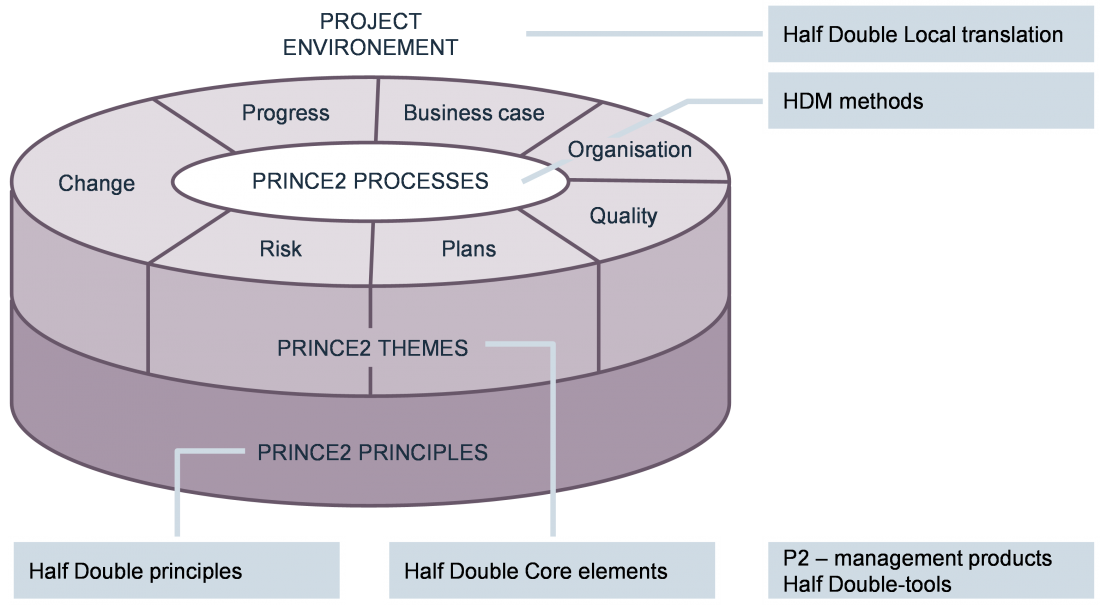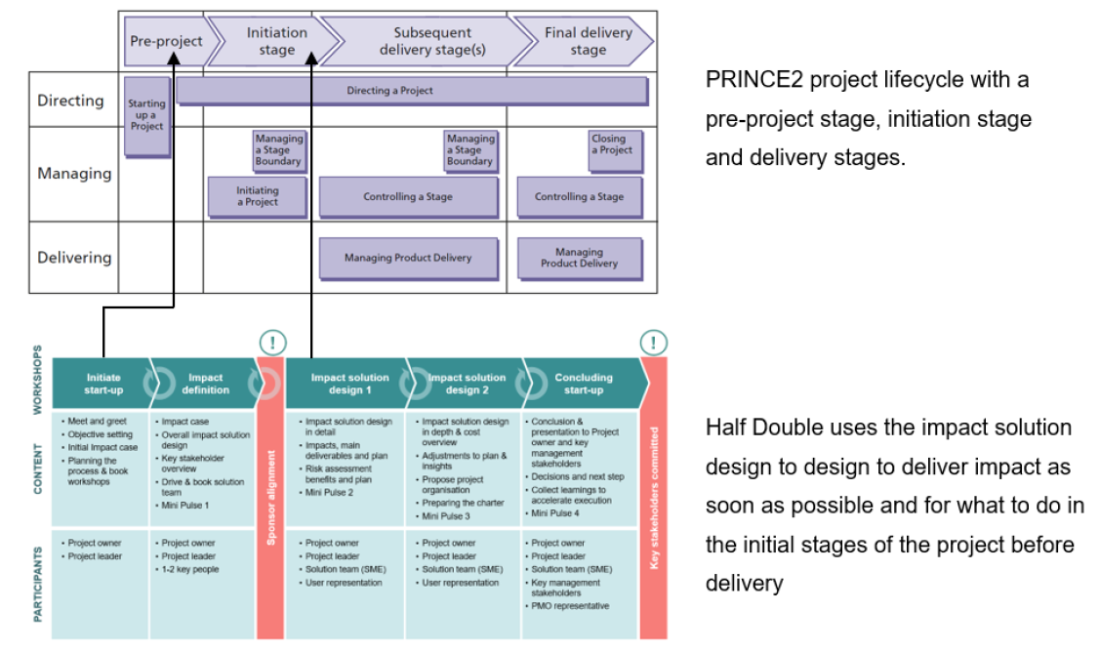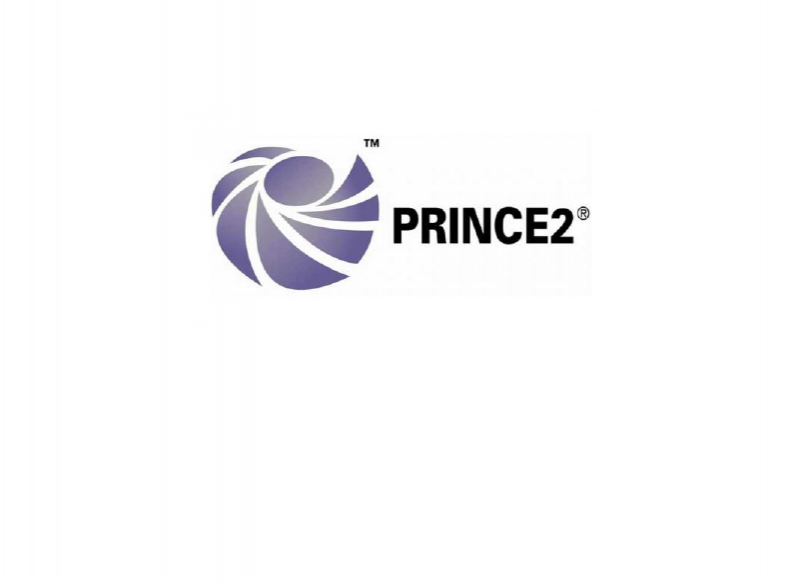HOW HALF DOUBLE COEXISTS WITH THE PRINCE2 STANDARD

Introduction
Purpose
The general purpose of the co-existence descriptions is to provide information to the project society as to how the Half Double Methodology can be used in combination with existing Project Management and Agile standards, models, methodologies, and frameworks currently being used by many project-oriented organisations.
Target group
This specific co-existence description is targeted to the group of people and organisations currently applying the PRINCE2 methodology and who are now considering or determined to also adopt, implement, and apply the Half Double Methodology. This document will inform how the PRINCE2 methodology can benefit from being used in combination with Half Double Methodology and vice versa.
Technical knowledge of projects and project management, agile initiatives, and agile project management, the Half Double Methodology 1.0 and PRINCE2 manual are prerequisites for being able to understand this document.
Both concepts are project management methodologies
A Project Management Methodology is defined as an organized collection of principles, methods, techniques, practices, procedures, and rules used by those who work with projects. Half Double and PRINCE2 are both project management methodologies.
Grafical illustration of the interactive “hot spots” between PRINCE2 6th edition and half Double Methodology (1.0)
The illustration provides an overview of how the two methodologies overlap and interacts with each other. The conclusion is evident: The number of similarities is higher than the differences, and there is a direct link between the elements of the two methodologies. 1) There is a direct relationship in principles and performance domains in the two methodologies and 2) P2 covers a comprehensive and instructive description whereas HDM focuses on selected performance domains. The illustration reflects the aligned areas between the two methodologies –. The illustration is based on the information in the cross-reference guide list in Annex 3.
How the PRINCE2 methodology and Half Double benefit from each other
Introduction
The PRINCE2 and the Half Double have similarities and differences. They are both generic methodologies, and when tailored they both fit into a broad range of projects and environments. PRINCE2 focuses primarily on structure, processes, governance, management documents and roles and responsibilities while Half Double is an agile hybrid focusing less on structures, processes and documentation and more on creating impact as early as possible, ensuring flow with high energy and fast progress with a fixed tact) and leadership between the key people.
PRINCE2 is generic and can be used for any kind of project. Half Double focus is change projects where change of behavior is a trigger for creating impact.
Half Double and PRINCE2 are complementary, meaning that the two approaches to project management, used in the right way, reinforces each other. Despite some build-in conflicts between the two standards there are several synergies if we focus on the overall use and intentions of the two approaches.
Half Double is an agile hybrid methodology embracing both ‘classical’ and agile project methods and thereby may support PRINCE2 projects in many ways and vice versa. You don’t need to choose either of the two methodologies. You can choose from both where needed. See more below.
Business justification and business case
Half Double Impact focus relates to the PRINCE2 benefit focus (ref. the cross-reference guide below). Note: where Half Double use the term Impact PRINCE2 use the term benefit.
Half Double provides concrete methods and tools to support the impact focus ensuring impact realisation e.g. the Impact case, Impact Solution Design, Early Impact and Pulse Checks.
PRINCE2 has a principle “continued business justification”, the business case and benefit review plan as well as a process for defining, updating, and following up on the business case and clear roles and responsibilities.
Half Double would benefit from the more instructive ways in PRINCE2, and PRINCE2 would benefit from both the focus on early impact, the distinction between business and behavioural impact, the cause-effect in the Impact case and the pulse checks to gain more and faster impact in the PRINCE2 projects.
Also, the Impact Solution Design from Half Double and its strong focus on early impact and how impact is guiding how we structure, plan and execute our project would be beneficial for PRINCE2 projects.
Example: Focus on impact and ownership
Both Half Double and PRINCE2 focus on which impacts to be realised and when, the needed deliverables to generate the (early) impacts, and responsibilities for it to happen. The Half Double Project owner – and the PRINCE2 roles the Executive and Senior User have accountability of the impact/benefits.
In a PRINCE2 project you identify and manage the Business Justification, a Business Case and a Benefit Review Plan which, among other elements, are captured in a PID. This work can be strengthened by creating a Half Double ‘Impact case where you align on the project impacts (behavioural and business) and agreeing on when, how and by whom the impacts shall be gained during and after the project. The PRINCE2 “business justification” will now have a roadmap towards creating impact.
In a PRINCE2 project you also build a Project Plan identifying necessary products to be delivered. The Half Double ‘Impact solution Design’ would help PRINCE2 projects to balance the focus on both impacts and deliverables, and it supports fast and continuous realization of the ‘right’ impacts throughout the project lifetime. The ‘Pulse Checks’ in Half Double helps you to be close to key stakeholder securing relevance, satisfaction and pace.
Project planning and execution
The core element Flow in Half Double can be related to planning and progress in PRINCE2.
Half Double provides concrete methods and tools that helps you execute fast, efficient and with high energy and motivation and a high focus on creating early impact.
Both methodologies have a strong focus on frontloading the projects before delivering.
PRINCE2 has a planning technique with detailed steps on how to plan, planning levels and instructions on steps and responsibilities throughout the project lifecycle.
PRINCE2 also has instructions on what to do and how if the project plans do not go as planned and we need to make a new plan.
Half Double could benefit from the idea of having more detailed instructions on how to plan. PRINCE2 could benefit from the idea of visual planning, core team allocation and co-location and the fixed tact from Half Double.
Example: Organisation and collaboration on planning
Both Half Double and PRINCE2 focus on progress and fast project execution towards impact/benefit realisation.
In a PRINCE2 project you differentiate between levels of accountability and processes when leading the project - Directing, Managing and Delivering the project which support the progress and flow and helps to ensure the right people with clear roles and responsibilities representing relevant key stakeholder perspectives.
Using the Half Double methods ‘Co-location design’ and ‘Visual planning’ you bring people together (physically or virtually) and make the project visual and thereby optimize synergies, energy, alignment, knowledge sharing, transparency, and collaboration between stakeholders at all levels. The strong focus on co-location, the high resource allocation of core team members and a fixed rhythm reduce transition costs and supports a more united teamwork and alignment understanding of the project – and creating a flow towards impact.
In a PRINCE2 project you also relate roles and responsibilities to the processes making sure that there is consistency and alignment in the project execution.
PRINCE2 could benefit from using the Half Double method ‘Rhythm in key events’ working with a fixed project heartbeat with common and fixed touchpoints to strengthen focus, alignment and flow. The Half Double use of visual planning and sprint plans can be merged with PRINC2 project stages approach using the best from both methodologies. Using an agile mindset and work approach in the execution phases has proven to support both impact and progress.
Half Double also work with different leadership levels (project leader, project owner, stakeholders, team) and could benefit from PRINCE2 in using the plan levels and the roles responsibilities per plan level and type.
Leadership support and ad-hoc work
The Leadership core element in Half Double relates to the PRINCE2 roles and responsibilities of the Project Board and the project manager. To get more impact earlier requires an active and dedicated leadership behaviour.
PRINCE2 includes clear roles and responsibilities for all key people in a project. PRINCE2 contains detailed instructions on where to engage and quite an elaborate list of detailed responsibilities in general but also specifically related to the themes. E.g., what is the responsibility of a project manager related to the business case or to quality management etc.
Half Double focuses on fewer roles. And especially the project owner is spot lighted - and the project manager, however, not as detailed, and instructive as in PRINCE2. However, in Half Double, you are supposed to spend a specific amount of time as a project owner to be an “active and engaged project owner”. Also, Half Double has instructions on how many projects can you own and still be active and engaged.
PRINCE2 does not advise specific leadership disciplines – rather management responsibilities, e.g., how the project board should direct the creation of the business case or when to approve the plans.
The project board accountability and responsibilities are quite extensively covered in the process ‘Directing a project’, in the theme ‘Organisation’ and in the Appendix C of the PRINCE2 manual. PRINCE2 does, however, acknowledge the existence and necessity of the leadership discipline, however, refers to general leadership disciplines covered by other standard models and books.
The same goes for the project manager’s role as a leader. PRINCE2 covers the management discipline, e.g., how to work with the team leader during development of the products or seeking approval of the PID. When it comes to leadership, like motivation, how to engage, and other classic leadership disciplines, the PRINCE2 manager is advised to seek guidance in the classic leadership knowledge.
Half Double projects could benefit from PRINCE2 in looking into the role descriptions and the mapping of roles and themes. PRINCE2 could benefit from the description of the active and engaged project owner and the collaboration between the project manager and the project owner, e.g., in the pulse check discussions.
PRINCE2 has the project board (steering committee) as a key role for ensuring progress and the right and balanced focus of the three interests (client, strategy, and supplier). Half Double does not mention the steering committee and does not consider it to be as important as PRINCE2. In Half Double the outcome of the project board role is ensured by the active project owner role and the collaborative leadership approach.
Half Double could benefit from PRINCE2 in acknowledging the three interests that all need to be part of the project to ensure explicitly that we can deliver, what the users need and what the organisation need and aims for.
PRINCE2 could benefit from the active ownership and the close relationship between the project owner and the project manager. Also benefit from the collaborative leadership ensuring even better and even more integrated teamwork between the project and the key stakeholders.
Example: Directing/leading and managing a project
Both Half Double and PRINCE2 obviously want to use the project resources as optimal as possible. Motivated people, delegated responsibility and smooth interactions means more efficient project execution. The right approach to leadership approach is therefore critical in all projects
Using the Half Double method ‘Active ownership approach’ (HDM) you will strengthen the leadership role of the project board with concrete advices on behaviour, and by a focusing strongly on active participation and true commitment, you will get high engagement, empowerment, and responsibility in the project group for making the project happen.
In a PRINCE2, the project manager usually ‘only’ manages the project on behalf of the steering committee. Using the Half Double methods ‘Collaborative leadership approach’ and ‘Reflective and adaptive mindset’ (HDM), the project manager will be a project leader leading people focusing on purpose, autonomy, energy, motivation – and not only on managing them. Half Double adds a strong people perspective and supports the project work form with an agile mindset allowing uncertainty in our strive for obtaining most possible impact.
PRINCE2 projects could also benefit from the pulse checks as a leadership discipline to ensure even better alignment and conversations with the project owner and other key stakeholders.
Tailor to suit the project environment
The Half Double Methodology’s (HDM) local translation focus is about ‘one size doesn’t fit all’ and that all projects need to consider the context of the project.
PRINCE2 works by the principle ‘Tailor to the environment’ and advises how the application of PRINCE2 in the individual project should be tailored to the context of the actual project and how to embed (implement) PRINCE2 in the organisation.
Both approaches can, if wisely tailored, be applied regardless of project type, size, organization, geography, or culture. Both methodologies can be used because they are designed to be tailored to its specific needs.
Example: Balancing governance and human aspects
Both Half Double and PRINCE2 want to tailor the work to the project’s surroundings, size, environment, importance, complexity, capabilities, maturity, and risk willingness.
In both cases we need to ensure that the project management methods relate to the project environment. E.g., aligning the methods used supporting the business processes, governance, project support and the impact realization with the human resources, leadership, finance, and procurement.
Tailoring and translation to the local environment requires an active decision and action from the project owner / project board and the project manager on how the methods must be applied.
Summarizing
The PRINCE2 Methodology gives good and detailed answers to several key disciplines in project management, e.g., risk management, business cases, organisation, planning, quality management definition of roles and responsibilities and product description outlines.
The Half Double methodology is complementary with a clear aim of increasing the success rate of projects in general, meaning realizing even more (and earlier) impact with high commitment, alignment, energy, motivation, and collaboration.
By adopting and implementing the Half Double methodology, you will effectively boost your PRINCE2 projects’ execution and outcome and make you more efficient in managing projects and with a clear focus on collaboration on creating early impact. You will in an easy and rewarding way be able to benefit from the most impactful elements of the agile elements from Half Double in your projects – even with simplifying your management of the project
On the other hand, Half Double projects would benefit from the detailed instructions in PRINCE2 on how to manage, roles descriptions and the management products (documentation), and the classic project management disciplines like risk management and quality management.
In the cross-reference overview/table below, we elaborate more PRINCE2 competence elements supporting the Half Double methodology.
Download the full document "Coexistence between Half Double and PRINCE2" underneath.
By adopting and implementing the Half Double methodology, you will effectively boost your PRINCE2 competences and execution muscle and making you more efficient in managing projects and agile assignments.
For more descriptions of Half Double's coexistence with other PM standards clic…Grafical illustration of the interactive “hot spots” between PRINCE2 6th edition and half Double Methodology (1.0)

Both methodologies have a strong focus on frontloading the projects before delivering


